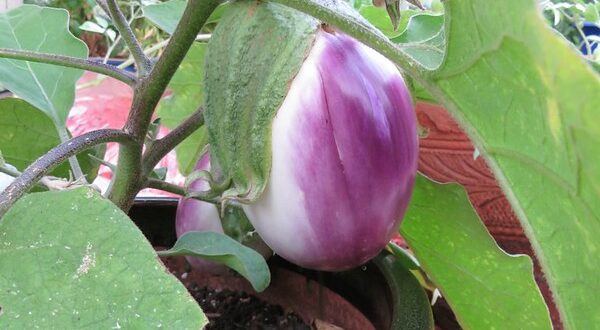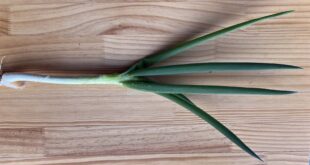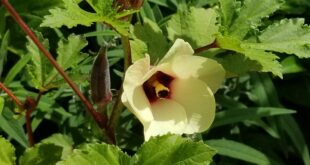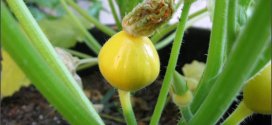Rosa Bianca is a joy to behold – lavender/rose with white markings in a round, Rubenesque teardrop shape. This Italian heirloom is particularly creamy and tender. Pick on the small side when about 5″ to 6″ and still brilliantly shiny, before seed formation begins.
One of the most widely used vegetables in global cuisines, Eggplant is low in fat and carbohydrates. I love it in ratatouille, moussaka and vegetable roasts as well as 3-Cheese Eggplant Parmesan, Aubergine Lemon Chicken, Eggplants Baked with Gingered Red Pepper Puree. Rosa Bianca is perfect for stuffing with savory, garlicky fillings such as cooked Italian sausage topped with Pecorino Romano. (OP.) More cooking tips below.
Eggplant has been cultivated in southeastern Asia since time immemorial. A member of the Nightshade family of the species Solanum melongena, it is also commonly known as Aubergine. Tropical, heat-loving Eggplant is best grown as transplants. Just like tomato and pepper plants, eggplant prefer full-sun: 6-8 hours a day.
Eggplant is a heavy feeder and should be grown in organically rich soil. Harvest after 70 to 80 days when the skin is thin and shiny, using a sharp blade.
Eggplant Sowing Instructions
To speed germination, soak seeds in warm water for one hour before sowing. Sow 8 to 10 weeks before setting out, after all threat of frost has passed and nighttime temperatures are reliably above 55°F.
- Planting Depth: 1/4″
- Row Spacing: 18”-24”
- Plant Spacing: 12”-18”
- Days to Germination: 7-12 days
- Germination Temperature: 70°-90°F
An Ounce of Prevention
Young eggplant seedlings have little leaf surface to spare, and are especially vulnerable to flea beetle predation. Covering the bed with lightweight floating row covers as soon as you set out the plants will usually help.
Egging on Eggplant
Of all the nightshade family (Eggplant, Tomato, Pepper or Potato), Eggplant is the one that needs the most heat to produce an abundant harvest. If your climate is a chilly one, laying down black plastic on the soil will help the plants to set and ripen fruit. Just cut an “X” where each little transplant needs to go and set it in. If you use one of the “IRT” (infra-red transmitting) plastics, you’ll speed progress even more.
Ornamental Eggplant
Eggplants are beautiful to look at, with their large, dark-veined leaves and glossy fruits, especially when you grow a variety of colors–pink, red, white, green or the classic deep purple. Why not showcase them in planters? Since the soil in containers warms up faster, they’ll bear sooner than your in-ground plants, and if raised up off the ground, may escape early assaults by flea beetles as well. Try one or two in a whisky barrel, surrounded with curly parsley, dusty miller, and pink-flowered scented geraniums for a romantic look. Or blazing French Marigolds for the Mardi Gras effect.
Cooking Tips:
Salting slices of Eggplants and letting the liquid drain out of them is a good way to make them less spongy, so that they absorb less oil when frying. It is also said to draw out bitterness, though personally I don’t find well-grown eggplants especially bitter tasting. I salt one side and let them rest on paper towels, salted side down, for 20 minutes or so, then do the same for the other side. After that I rinse them under the tap, removing the salt and squeezing the slices hard. Then I fry them lightly in olive oil. I find that the water they do retain makes them cook beautifully, and the oil they absorb is just a light, flavorful coating.
There are many versions of the story behind Imam Bayildi, a Turkish Eggplant dish which translates as “the priest fainted”. In my favorite, the Eggplant soaked up so much oil that it consumed the Imam’s wife’s dowry, which consisted of great jugs of olive oil. Anyone who has fried Eggplant would find this quite plausible. The usual remedy is to salt Eggplant slices heavily before frying them and let them sit a while. This draws out water and somewhat reduces their porosity. I also squeeze them firmly as I rinse off the salt, so that they are flattened. They fry beautifully and soak up much less oil.








